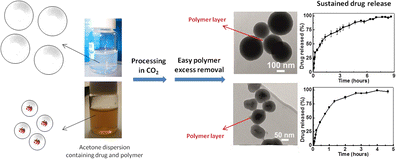
HOT FROM THE PRESS
Compressed antisolvent process for polymer coating of drug-loaded aerogel nanoparticles
Nerea Murillo-Cremaes, Pascal Subra-Paternault*, Javier Saurina, Anna Roig*, Concepción Domingo*
Colloid and Polymer Science (2014) DOI 10.1007/s00396-014-3260-6, published on-line June 2014
 The overall objective of the present work was to modulate the release behavior of drug-impregnated silica particles from almost instantaneous release to a more sustained delivery, prolonged during several hours. Triflusal was chosen as a model drug of the low biodisponibility type. The process is based in the coating with Eudragit® RL 100 polymer of aerogel-like silica particles. Materials were processed in compressed CO2 by using the batch and semicontinuous antisolvent coating methods. Triflusal release from Eudragit-coated aerogel particles was compared with the dissolution profiles recorded for pristine triflusal and for triflusal impregnated into polymer or non-coated aerogel particles. The release profiles were determined by high-performance liquid chromatography. Eudragit-coated materials presented an intermediate drug-release rate between this obtained for the infused polymer and that of the impregnated aerogel particles. Diffusion-governed mechanisms were found for the studied aerogel-like systems after fitting the release data to both Korsmeyer-Peppas and Baker-Lonsdale equations. The major advantage of the compressed CO2 antisolvent approach was the ability to physically coat very fine particles. Moreover, the stability of the studied drug in water increased after coating.
The overall objective of the present work was to modulate the release behavior of drug-impregnated silica particles from almost instantaneous release to a more sustained delivery, prolonged during several hours. Triflusal was chosen as a model drug of the low biodisponibility type. The process is based in the coating with Eudragit® RL 100 polymer of aerogel-like silica particles. Materials were processed in compressed CO2 by using the batch and semicontinuous antisolvent coating methods. Triflusal release from Eudragit-coated aerogel particles was compared with the dissolution profiles recorded for pristine triflusal and for triflusal impregnated into polymer or non-coated aerogel particles. The release profiles were determined by high-performance liquid chromatography. Eudragit-coated materials presented an intermediate drug-release rate between this obtained for the infused polymer and that of the impregnated aerogel particles. Diffusion-governed mechanisms were found for the studied aerogel-like systems after fitting the release data to both Korsmeyer-Peppas and Baker-Lonsdale equations. The major advantage of the compressed CO2 antisolvent approach was the ability to physically coat very fine particles. Moreover, the stability of the studied drug in water increased after coating.

